
Star Control: Famous Battles of the Ur-Quan Conflict, Volume IV is an action-strategy video game developed by Toys for Bob and published by Accolade. It was originally released for MS-DOS and Amiga in 1990, followed by ports for the Sega Genesis and additional platforms in 1991. The story is set during an interstellar war between two space alien factions, with humanity joining the Alliance of Free Stars to defeat the invading Ur-Quan Hierarchy. Players can choose to play as either faction, each with seven different alien starships which are used during the game's combat and strategy sections.
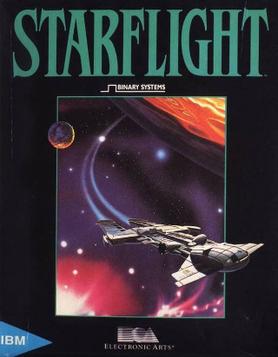
Starflight is a space exploration, combat, and trading role-playing video game created by Binary Systems and published by Electronic Arts in 1986. Originally developed for IBM PC compatibles, it was later ported to the Amiga, Atari ST, Macintosh, and Commodore 64. A fully revamped version of the game was released for the Sega Genesis in 1991.
The Ur-Quan Masters is a 2002 open-source fangame modification, based on the action-adventure science fiction game Star Control II. The original game was released for PCs in 1992 and ported to the 3DO Interactive Multiplayer in 1994. It has been frequently mentioned among the best games of all time, with additional praise for its writing, world design, character design, and music.

Starflight 2: Trade Routes of the Cloud Nebula is a 1989 science fiction video game developed by Binary Systems and published by Electronic Arts as the sequel to the successful Starflight. It features a combination of space exploration, role-playing and strategy within a futuristic setting. The player commands a spaceship capable of traveling to the game world's 150 solar systems, communicating with or attacking other spaceships, and landing on planetary surfaces which may be explored with a crewed rover for plot clues, minerals and alien lifeforms. Game mechanics and the overall look and feel closely resemble the earlier Starflight game, but many new features are introduced including an interstellar trade-based economy, new sentient alien races, and new spacecraft accessories and artifacts. The player is tasked with discovering the ultimate source of the advanced spacecraft technology and unlimited fuel supply which provide a military advantage to the Spemin, a hostile alien race threatening to annihilate or enslave humanity. A major part of the game consists of earning enough money to pay for spaceship upgrades and crew training by engaging in interstellar trade and barter with various alien cultures at their planetary trading posts.

Accolade, Inc. was an American video game developer and publisher based in San Jose, California. The company was founded as Accolade in 1984 by Alan Miller and Bob Whitehead, who had previously co-founded Activision in 1979. The company became known for numerous sports game series, including HardBall!, Jack Nicklaus and Test Drive.
Robert Frederick Ford is an American video game programmer. He is the son of mathematician L. R. Ford Jr. A co-founder of the video game studio Toys for Bob, he led the company from its inception until late 2020 with his co-founder Paul Reiche III. Ford is the co-creator, with Reiche III, of the Star Control universe. Ford did the programming, while Reiche was responsible for the game design and fiction. Ford was also the lead programmer on The Horde and Pandemonium.

Paul Reiche III is an American game designer. His career started in the pen and paper RPG industry, where he collaborated with artist Erol Otus on games such as Dungeons & Dragons and Gamma World. He then transitioned into video games, working with Jon Freeman to establish Free Fall Associates and developed titles like Mail Order Monsters, World Tour Golf, and Archon. Later, he left Free Fall to establish Toys for Bob with Fred Ford. Their first collaboration resulted in Star Control. After a successful sequel, they declined to make a third installment, instead focusing on other projects including the successful Skylanders franchise.

Mail Order Monsters is an action-strategy computer game created by Paul Reiche III, Evan Robinson, and Nicky Robinson. It was published by Electronic Arts for the Commodore 64 in 1985, then released for Atari 8-bit computers in 1986. Players create monsters which they can use to battle multiplayer or against computer-controlled opponents.
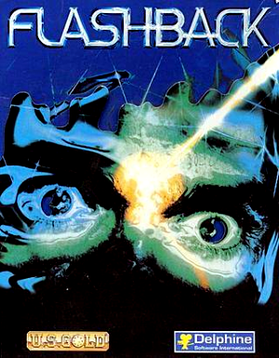
Flashback, released as Flashback: The Quest for Identity in the United States, is a 1992 science fiction cinematic platform game developed by Delphine Software of France and published by U.S. Gold in the United States and Europe, and Sunsoft in Japan.
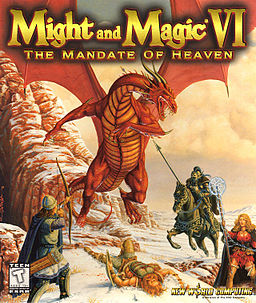
Might and Magic VI: The Mandate of Heaven, commonly abbreviated to Might and Magic VI or simply MM6, is a role-playing video game developed by New World Computing and published by 3DO in 1998. It is the sixth installment in the Might and Magic series, the sequel to Might and Magic V: Darkside of Xeen and the first of the Might and Magic titles to take place on the same planet as Heroes of Might and Magic. It continues the storyline of Heroes of Might and Magic II, and takes place at the same time as Heroes of Might and Magic III in the series chronology. The game was compared favorably to its peers, role-playing video games such as The Elder Scrolls II: Daggerfall. Critics praised it for its non-linear, user-friendly premise, an interactive, detailed game world and a polished, bug-free initial release. A Limited Edition version of the game was also released, including a cloth map of Enroth, a strategy guide and the first five games of the series on CD-ROM. It was followed by three sequels, with Might and Magic VII: For Blood and Honor directly continuing the story arc.
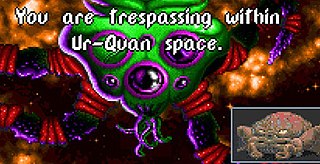
The Ur-Quan are a fictional race of predatory alien caterpillars in the Star Control series of video games, created by Paul Reiche III and Fred Ford. Introduced in 1990, the Ur-Quan are the primary antagonist of the first game, leading a galactic empire that seeks to enslave Earth. They reprise their role in Star Control II, which expands on their history as former slaves who since vowed to fiercely defend themselves. During the game, the Ur-Quan enter into a civil war over their ideology, giving Earth an opportunity to defeat them. In Star Control 3, which was developed by a different team, the Ur-Quan ally with Earth against a different antagonist and their role is scaled back. They appear once again in The Ur-Quan Masters, the 2002 open source remake of Star Control II.

Heroes of Might and Magic II: The Succession Wars is a turn-based strategy video game developed by Jon Van Caneghem through New World Computing and published in 1996 by the 3DO Company. The game is the second installment of the Heroes of Might and Magic series and is typically credited as the breakout game for the series. Heroes II was voted the sixth-best PC game of all time by PC Gamer in May 1997.
Toys for Bob, Inc. is an American video game developer based in Novato, California. It was founded in 1989 by Paul Reiche III and Fred Ford and is best known for creating Star Control and the Skylanders franchise, as well as for working on the Crash Bandicoot and Spyro franchises.

Wing Commander is the first game in Chris Roberts' space flight simulation Wing Commander franchise by Origin Systems. The game was first released for MS-DOS on September 26, 1990 and was later ported to the Amiga, CD32 (256-color), Sega CD and the Super Nintendo Entertainment System, and re-released for the PC as Wing Commander I in 1994. An enhanced remake Super Wing Commander was made for the 3DO in 1994, and later ported to the Macintosh.

MechWarrior 2: 31st Century Combat is a vehicle simulation game developed and published by Activision, released in 1995 as part of the MechWarrior series of video games in the BattleTech franchise. The game is set in 3057, and is played as a tactical simulation that incorporates aspects of real-time first-person combat and the physical simulation of the player's mech. It is a game recreation of the "Refusal War." The player can join one of the clans, Clan Jade Falcon or Clan Wolf while engaging in up to 32 missions.
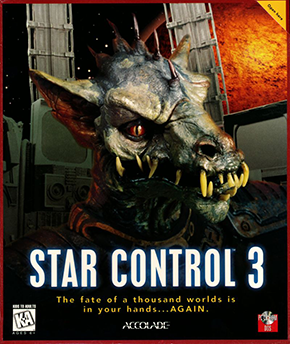
Star Control 3 is a 1996 action-adventure game developed by Legend Entertainment and published by Accolade. The third installment in the Star Control trilogy, the game was released for MS-DOS in 1996 and Mac OS in 1998. The story takes place after Star Control II, beginning with a disaster that disrupts superluminal travel through hyperspace. This leads the player to investigate a new quadrant of space, joined by allied aliens from the previous games.

Star Control: Origins is an action-adventure game developed and published by Stardock Entertainment for Microsoft Windows, released September 20, 2018.

Stardock Systems, Inc. v. Paul Reiche III and Robert Frederick Ford, 2018 WL 7348858, is a case where the United States District Court for the Northern District of California applied American intellectual property law to the contents and sale of computer games. Paul Reiche III and Fred Ford are the makers of the critically acclaimed 1990 Star Control game series, and Stardock is the maker of the 2018 release Star Control: Origins. The lawsuit stems from a dispute over the ownership, licensing, and infringement of the Star Control intellectual property, including both trademarks and copyrights.
Free Stars: Children of Infinity is an open world space game, and the upcoming sequel to The Ur-Quan Masters. The game began development in 2021 under Pistol Shrimp, a new studio co-founded by Star Control creators Fred Ford, Paul Reiche, Ken Ford and Dan Gerstein. As the copyright holders in the original story, Reiche and Ford intend to continue the saga from the previous games' events. It is planned for release in 2025.
Pistol Shrimp Games is a video game studio created by Fred Ford, Ken Ford, Paul Reiche and Dan Gerstein after leaving Toys for Bob in 2021. The company was started on April 5, 2022.


















